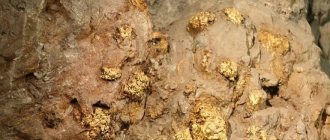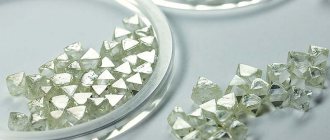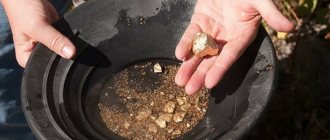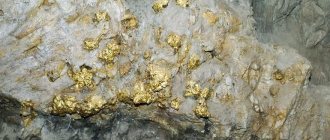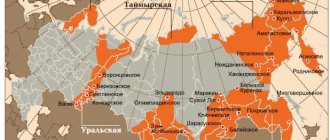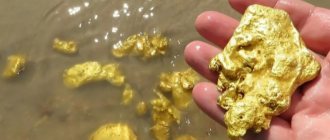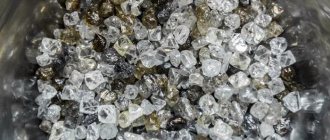- September 17, 2019
- Directions
- Victoria Samarskaya
This article will be useful to those who are interested in where gold is mined in Russia: cities, deposits, enterprises. Our country is among the top three in mining the yellow metal, second only to China and Australia. Most of the mines are geographically located in the southern and central regions of our country.
Major gold mining companies
We list the largest ones that provide industrial production of the yellow metal:
- PJSC Polyus, spun off from OJSC Norilsk Nickel in 2006. The main owners are Suleiman Kerimov (37% of shares) and his family. This is one of the world's largest enterprises engaged in gold mining in the Irkutsk, Krasnoyarsk, Magadan and Amur regions. Based on the geography of the company's mines, you can understand where gold can be found in Russia.
- Kinross Gold is an international company headquartered in Toronto. On the territory of the Russian Federation, it is developing the Kupol field in Chukotka (Anadyr region).
- JSC "UGK" is a group engaged in gold mining both open and closed methods in the Krasnoyarsk Territory, Chelyabinsk Region and the Republic of Khakassia.
- PJSC Severstal, which separated gold mining assets into an independent enterprise Nordgold, which has international status. Owns five mines in the Russian Federation (Amur Region, Buryatia, Republic of Sakha).
- JSC Polymetal, which ranks second in Russia in terms of gold production. Its deposits are located in the Urals, Chukotka, and Magadan region.
- PJSC "Vysochaishy" It was created to develop the Golets Vysochaishy mine (Irkutsk region), but also mines the yellow metal in the Republic of Sakha.
Gold mining industry in Russia
In Russia, gold reserves are recorded in 372 primary deposits, as well as in more than 5,000 placer deposits. In terms of the amount of gold reserves, Russia is second only to South Africa, possessing 12.5 thousand tons of the precious metal, or more than 11% of the world's reserves; Of these, industrial reserves (categories A+B+C1) account for about two-thirds, or approximately 8 thousand tons of metal.
In terms of gold production in 2011, Russia, ahead of South Africa, again took fourth place in the world after China, Australia and the United States.
About the extraction of yellow metal by private owners
You can often hear the question of where private owners mine gold in Russia. Many experienced a period when any person, practically without any official permission, could engage in mining and washing yellow sand. This is the 90s: from 1992 to 1998. Today, illegal mining is subject to a large fine and confiscation of equipment. There is also criminal liability for storing reserves worth more than 1 million rubles. Despite the ban, up to 10% of production comes from illegal gold miners.
But from 2022, individuals have the opportunity to obtain a license to develop small plots (150 thousand sq. m.). To do this, you need to register an individual entrepreneur. Private owners have many restrictions: the license period is 5 years, miners do not have the right to use hired labor and heavy equipment. Extraction is carried out exclusively by hand. The Rosnedra agency has a register of vacant sites, but official registration of prospectors is proceeding slowly. The point is taxation (on profit and production), as well as the need to carry out exploration ourselves and take care of safety.
ALROSA outside Russia
AK ALROSA conducts major activities in the South African Republic of Angola. Here she owns about 33% of the shares of the local mining company - Africa's largest diamond producer. Cooperation began in 2002, after several meetings at the level of senior management in the capital of the republic, the city of Luanda, an ALROSA branch was opened.
In marketing its specific products, ALROSA has opened several sales branches around the world - in London (UK), Antwerp (Belgium), Hong Kong (China), Dubai (United Arab Emirates), as well as in the USA and Israel. These countries are the location of the main rough and polished diamond trading centers, where they are sold at special auctions and tenders.
Where is gold mining done?
If a person is puzzled by the question of where to mine gold in Russia himself, then he should contact the Rosnedra agency for the allocation of a free plot. The most promising ones are those where existing mines were previously located. Thus, in the Amur region, a deposit in which gold mining has been carried out since the 19th century has been closed. Surely there is something to profit from there today.
Areas that are currently being developed industrially using heavy equipment are also considered promising. Private owners have the opportunity to enter into agreements with large companies, which, for a certain percentage, allow mining of the yellow metal in territories that are inconvenient for them. Such large testing grounds are located in Yakutia and the Urals. Dense soils are considered the most promising, which is why most prospectors are in the east of the country and in the taiga. Where in Russia are deposits of precious metals located?
Where does gold come from?
Metals with an atomic mass of more than 55 units (heavier than iron), which cannot be formed inside stars, arise as a result of gamma-ray bursts - releases of energy in space during supernova explosions. Gold came to Earth with asteroids many years ago, when our planet was just being formed and had no atmosphere. Most of the heavy elements sank below the Earth's surface and formed the core.
There are few precious metals on the surface. Their main volume is located in the mantle - the substance between the earth's crust and core. In the upper layers of the mantle, a hot melt is formed - magma, which in some places penetrates the surface of the Earth. There it hardens and turns into solid rock, containing almost the entire periodic table.
Magma is heterogeneous, hardens unevenly - refractory substances coexist with low-melting substances, and the latter continue to circulate inside the solidified former. This is how gold veins are formed within the rock.
Geography of gold mining
On the map just above you can see that most of the gold deposits are located in the Urals and beyond the Urals. In the central part there are only three gold mining provinces. We are talking about the Karelo-Kola, Caucasian and Dnieper-Don zones. The main reserves of the yellow metal are represented in the Asian territory of the Russian Federation. When asked where gold is mined in Russia, any representative of this industry will name Chukotka, Amur, Magadan, Bodaibo, Taximoto and the Urals. By the way, one of the largest nuggets was found in Bilibino (Chukotka). His weight was 16 kg. Let us list the most famous deposits where work is being carried out today.
Gold deposits in Russia
The most promising areas for searching for gold nuggets in Russia are located in its Asian part - these are the Urals, Bodaibo, Taximo, Amur, Magadan, Chukotka
.
One of the large nuggets found in the Bodaibo region weighs 12.3 kg. In Chukotka (Bilibino), quite recently, a 16 kg nugget was found. In the Amur region on the Cuttlefish
, in the estuary part, 665 nuggets were found, the largest of which was 6.9 kg, and on the
B. Chanchik
in 2000 a nugget of 3.5 kg was found.
The list below of 46 (so far) gold mines and mines in Russia is divided by latitude-longitudinal zones. The belts are listed from west to east and are grouped by gold provinces (GMPs), within geographic zones or folded areas.
Gold mining provinces of the European part of the Russian Federation
In the European part of Russia there are 3 gold mining provinces: Karelo-Kola
,
Dnieper-Don
and
Caucasian
. Geographical and setallogenic information on the gold mines of these provinces is not yet available. Geographically, the gold mining geological unit No. 2 (“Buisky”) belongs to the Karelo-Kola ZRP.
Gold fields of the Caucasus province
The Kakadur ore zone is the only potential deposit of the precious metal in Ossetia.
The Sotk gold deposit is the largest in terms of pure gold reserves in Azerbaijan and Armenia.
Gold mining provinces of the Urals and Trans-Urals
The gold belts of Western Siberia listed below lie within the Siberian Trap
.
They belong to 4 gold mining provinces: Ural
,
Taimyr-Severo-Zemelskaya
,
Altai-Sayan
and
Baikal-Vitim
.
Gold-bearing belt from 50 to 60 N latitude. and from 60 to 65 east. (Ural)
- Berezovskoe
: - from 55 to 60 northern latitudes. and from 60 to 65 east. - Vorontsovskoe
: - from 55 to 60 north latitude. and from 60 to 65 east. - Kochkar
, or Kochkar gold deposit: - from 50 to 55 north latitude. and from 60 to 65 east. - Svetlinskoe
: - from 50 to 55 northern latitudes. and from 60 to 65 east.
Gold-bearing belt from 50 to 65 N latitude. and from 85 to 95 east.
- Kommunarovskoe
: - from 50 to 55 northern latitudes. and from 85 to 90 east. - Konstantinovskoe
: - from 50 to 55 northern latitudes. and from 90 to 95 east. - Olympics
(Olimpiada): - from 55 to 60 latitudes. and from 90 to 95 east. - Saralinskoe
(Saralinskoe): - from 50 to 55 northern latitudes. and from 85 to 90 east. - Soviet
(Sovetskoe): - from 60 to 65 northern latitudes. and from 90 to 95 east.
Gold-bearing belt from 45 to 55 N latitude. and from 100 to 105 east.
- Zun-Holba
: - from 50 to 55 north latitude. and from 100 to 105 east.
This zone also includes the Mongolian gold mines of Bumbat Gold Fields
(Bumbat Gold Fields) and Boro (Boroo).
Gold-bearing belt from 50 to 60 N latitude. and from 115 to 125 east. (Irkutsk region)
The northern part of this gold zone (from 55 to 60 N) belongs to the GZS zone No. 4 (60 N 120 E).
The springs closest to this point are marked in red. And mines that fall within the “statistical intersection” (i.e., in the range from 50 to 55 N and 115 to 120 E) are marked with an asterisk (see Conclusions).
- Verninskoe
(Verninskoe): - Irkutsk region (from 55 to 60 N and from 115 to 120 E) - Golets Vysochaishiy
: - Irkutsk region (from 55 to 60 N and from 115 to 120 E) - Darasun *
(Darasun): - Siberia region (from 50 to 55 N and from 115 to 120 E) - Kariisk *
(Kariisk): - region of Siberia (from 50 to 55 N and from 115 to 120 E) - Klyuchevskoe *
(Klyuchevskoe): - Siberia region (from 50 to 55 N and from 115 to 120 E) - Pokrovskoye
: - from 50 to 55 northern latitudes. and from 120 to 125 east. [east of others] - Sukhoi Log
: - Irkutsk region (from 55 to 60 N and from 115 to 120 E) - Taseevo *
(Taseevo): - region of Siberia (from 50 to 55 north latitudes and from 115 to 120 east longitudes) - Ukoninskoe *
(Ukoninskoe): - region of Siberia (from 50 to 55 N and from 115 to 120 E) - Chertovo Koryto
: - Irkutsk region (from 55 to 60 N and from 115 to 120 E) - Broad *
(Shirokaya): - Siberia region (from 50 to 55 N and from 115 to 120 E)
Sukhoi Log gold deposit
The deposit is located within the Bodaibinsky synclinorium, in the Kropotkinsky ore cluster, which occupies the central part of the synclinorium. The deposit belongs to the quartz-sulfide veinlet-disseminated type, combined with subordinate thin veins of quartz and gold-quartz composition.
The Kropotkinsky ore cluster is confined to the northern wing of the Maracan-Tunguska syncline, complicated by smaller folds. The unit is composed of a thick sequence of sedimentary rocks of the Patom series PR3, which is subdivided (from bottom to top) into the Ballaganakh, Kadalikan and Bodaibo subseries hosting the mineralization. Intrusive rocks in the node are represented by a large Konstantinovsky stock of granites PZ1 (Concudero-Mamakan complex) and a series of quartz porphyry dikes. These igneous rocks are absent within the deposit, and the deposit has no clearly defined connections with magmatism. Lower Proterozoic rocks are regionally altered in the chlorite-sericite subfacies of the greenschist metamorphic facies.
Gold mining provinces of Eastern Siberia
The gold belts of the Far East listed below in the north lie within the Verkhneyansk-Chukchi fold region
(
Verkhoyansk-Kolyma
,
Kolyma-Omolon
,
Novosibirsk-Chukotsk
,
Okhotsk-Chukotsk
,
Koryak-Kamchatka-Kuril
ZRP), in the south - not yet represented (
Mongol-Okhtskaya
,
Aldano-Stanovaya
,
Sikhote-Alinskaya
).
V.-Ch. With. O. - one of the most important ore provinces in the world. There are large deposits of gold (the basin of the rivers Boryolekh, Nera, Ayan-Yuryakh, etc.), tin (Deputatskoye, Chukotskoye), polymetallic ores and ores of rare earth elements (Imtanja, Tokichanskoye, Bulunginskoye, etc.), mercury, as well as stone coal (Zyryansky basin).
Gold-bearing belt from 50 to 60 N latitude. and from 125 to 140 east.
- Kuranakh
: - from 55 to 60 N latitude. and from 125 to 130 east. - Mnogovershinnoe
: - from 50 to 55 N latitude. and from 135 to 140 east. [east of others] - -Yuryakh
: - from 55 to 60 N latitude. and from 135 to 140 east. - Tokur
: - from 50 to 55 northern latitudes. and from 130 to 135 east.
Gold-bearing belt from 60 to 70 N latitude. and from 130 to 140 east.
- Kyuchus
: - from 65 to 70 north latitude. and from 130 to 135 east. - Nezhdaninskoye
: - from 60 to 65 north latitude. and from 135 to 140 east.
Gold-bearing belt from 60 to 65 N latitude. and from 140 to 155 east. (Magadan Region)
On the territory of the Magadan region
There are about 2,000 placer gold deposits and about 100 ore gold deposits.
The total forecast gold reserves of the Magadan region are estimated at 4,000 tons, which is more than 11% of the explored placer gold reserves and 15% of the all-Russian ore gold reserves. The largest deposit is Natalka
, proven gold reserves are more than 250 tons.
There are also about 48 deposits of ore silver in the region. The main deposit is Dukat
"with reserves of 14.8 thousand tons. The general forecast of silver reserves is more than 80 thousand tons (about 50% of the total volumes of explored reserves in Russia).
- Juliet
(Julietta): - region of Magadan region. (from 60 to 65 N and from 150 to 155 E) - Dukat
: - Magadan region. (from 60 to 65 N and from 150 to 155 E) - Kakanja
, or
Khakanja
(Khakandzha): - from 60 to 65 north latitude. and from 140 to 145 east. [west of others] - Karamken
: - region of Magadan region. (from 60 to 65 N and from 150 to 155 E) - Lunnoe
: - region of Magadan region. (from 60 to 65 N and from 150 to 155 E) - Natalka
: Magadan region (from 60 to 65 N and from 145 to 150 E) - Svetloye
: Magadan region (from 60 to 65 N and from 145 to 150 E) - Shkolnoe
(Shkolnoe): Magadan region (from 60 to 65 N and from 145 to 150 E)
Khakanja field
The Khakanja silver and gold deposit is located in the Okhotsk region of the Khabarovsk Territory, 100 km north of the village of Okhotsk in the area between the Okhota and Kukhtui rivers. Discovered in 1967 by employees of the North-Eastern Geological Survey. It received its name from a small river, on the right side of which outcrops of mineralized zones and metallometric halos of gold, silver and manganese were mapped. Confined to a paleovolcanic structure that formed in the Late Cretaceous ( Amkinsky
) stage of development of post-accretionary magmatism of the Okhotsk branch of the Okhotsk-Chukotka volcanic belt.
- Khakanja gold and silver deposit (geological structure, features of mineralization placement).
Gold-bearing belt from 50 to 60 N latitude. and from 155 to 165 east. (Kamchatka)
- Aginskoe
(Aginskoe): - from 55 to 60 north latitude. and from 155 to 160 east. - Asacha
: - Kamchatka region (from 50 to 55 north latitude and from 155 to 160 east longitude) - Mutnovsky
: - Kamchatka region (from 50 to 55 N and from 155 to 160 E) - Ozernovskoe
: - from 55 to 60 north latitude. and from 160 to 165 east. - Rodnikovoe
(Rodnikovy): - Kamchatka region (from 50 to 55 N and from 155 to 160 E)
Gold-bearing belt from 60 to 65 N latitude. and from 155 to 165 east. (Koryakia)
- Amethyst
(Ametistovoye): - from 60 to 65 north latitude. and from 160 to 165? e.d. - Evenskoe
: - from 60 to 65 north latitude. and from 160 to 165 east. - Kubaka
: - from 60 to 65 north latitude. and from 160 to 165 east.
Gold-bearing belt from 65 to 70 N latitude. and from 165 to 175 east. (Chukotka)
- Karalveem
: - Chukotka region (from 65 to 70 N and from 165 to 170 E) - Kupol
(Kupol - Deposit Name): - Chukotka region (from 65 to 70 N and from 165 to 170 E) - Maiskoe
: - from 65 to 70 north latitude. and from 170 to 175 east.
Magadan Region
This region is the leader in alluvial gold mining, although there are also ore deposits here. The development of deposits began in the region only in the 30s. XX century, and today there are already more than 547 deposits in Kolyma. They produce 14-17 tons of placer gold per year. We list the largest deposits:
- “Natalkinskoe” (Tenkinsky district, Omchak river). Discovered in 1942, it provides 79% of all gold reserves in the region.
- “Pavlik” (Tenkinsky district, near the village named after Gastello). Discovered in 1942, it provides 7.3% of the yellow metal reserves.
- "Perekatnoe" (North-Evensky district). Discovered in 1961 (5.7% of gold reserves).
If we are interested in where prospectors mine gold in Russia, then we should know: it is in this region that about 12 small deposits are listed in the undistributed fund. Their reserves are estimated at 356 tons. Therefore, private owners most often flock to Kolyma for success.
Import and export of gold by country of the world
The largest importers of gold, according to statistics from the International Trade Center for 2022, are:
- UK ($70.7 billion)
- Switzerland ($60.6 billion)
- China ($43.9 billion)
- India ($32.1 billion)
- Hong Kong ($13.9 billion)
- Türkiye ($11.2 billion)
- Singapore ($10 billion)
- USA ($9.6 billion)
- Thailand ($7 billion)
- UAE ($6.7 billion)
In total, in dollar terms, more than $306 billion worth of gold was imported in 2022. As for Russia , it is not among the top 50 countries for imports. Its gold imports in 2022 were only $15.8 million .
The largest exporters of gold in 2022, according to ICT statistics, are:
- Switzerland ($61.9 billion)
- Hong Kong ($25.1 billion)
- UK ($23.3 billion)
- UAE ($17.7 billion)
- USA ($17.1 billion)
- Australia ($16.2 billion)
- Canada ($15.3 billion)
- Singapore ($11.5 billion)
- Thailand ($7.5 billion)
- Peru ($6.7 billion)
Russia is in 13th place ; gold exports in 2022 amounted to $5.7 billion , although in previous years it was significantly less.
Chukotka
The autonomous region has taken 2nd place in the Russian Federation in gold mining. In total, approximately 25 tons of yellow metal are mined here every year. Mostly ore. The largest deposits are:
- “Dome” (border of Bilibinsky and Anadyr districts). Opened in 1991. Mining is carried out using both open-pit and open-pit mining methods. The depth of the quarry is 90 m. Its reserves are estimated at 65.5 tons.
- "Double" (Bilibinsky district). Opened in 1983. Reserves are estimated at 37 tons.
Both deposits are gold-silver. The region has many inaccessible places, so there are a large number of black miners active here. This is about the question of where gold can be mined in Russia.
Map of gold mining and Russia’s place on it
The geography of gold-mining countries around the world is constantly changing. For example, in the 80s, more than half of all gold production in the world came from South Africa, but ten years later its share in total world gold production dropped to one third.
Despite the fall of the African gold-mining power, the West increased gold production several times. Many countries that do not mine gold have begun to develop this industry. These include Papua New Guinea, the Philippines, Indonesia, and Latin American countries.
Gold mining in Russia, whose geographical map is vast and diverse, is available in many places. Not all of them are useful for industry. Those needed for the industrial processing of gold are divided into endogenous and exogenous.
This is what gold looks like with tellurides in quartz in an endrogenic mine.
Endogenous gold deposits come in several types. It is most advisable to mine in medium- and high-temperature hydrothermal deposits. They are represented by quartz veins and stockwork zones with sulfides.
Gold deposits formed due to volcanic activity are quite important for domestic gold mining.
Where precious gold is mainly mined in Russia can be determined by the geodetic situation. Such deposits lie close to the earth's surface. Among the famous ones: Khakanja in the Far East, Kuranahanskoye in Aldan and many others. Gold is also mined from pyrite-polymetallic deposits of Rudny Altai, magmatic copper-nickel deposits located in the north of the Krasnoyarsk region and from gold-bearing skarns, which are located in Olkhovka and Chibizhka at the junction of the Minusinsk Basin and the Eastern Sayan. Some of the most gold-mining regions are: Khabarovsk region, Krasnoyarsk region, Magadan and Irkutsk regions.
Map of gold mining in Russia.
The world leader in gold mining is China. This country produces about four hundred tons every year and 2014 was no exception. However, Russia does not stand still and is increasing the level of gold production; already in 2013 it could boast of solid results: two hundred and fifty-four tons of pure gold.
Saha Republic
20% of the republic’s total wealth is gold deposits. There are more than 800 mines here, including many small ones along the Bolshaya Kuranakh River. A gold rush swept the republic in the middle of the 19th century, after the indigenous residents began to give huge bullion to Russian merchants for next to nothing, without even suspecting their real value. More than half of the production is placer gold. Among the most famous deposits are:
- “Side”, “New” and “South”. They stretch for 10 km along Big Kuranakh. Layered deposits are developed here (western zone).
- “Severnoye”, “Yakutskoye”, “Delbe”, “Gagarskoye”, “Kanavnoye”, “Dorozhnoe”, “Korotkoye”, “Porfirovoe” (eastern zone). The total length of these deposits along the river is 25 km.
So, where is gold mined in Russia? Yakutia provides about 25 tons per year.
Classification of gold deposits
There are two types of deposits. They are divided into:
- primary, they are also radical;
- secondary - alluvial.
Indigenous
Primary deposits are the same fragments of magma ejected onto the surface of the globe. It happens that gold is present in the rock in the form of veins and nuggets, but more often it is alloyed with other elements: gold ores with copper, quartz, iron and sulfur compounds, and polymetallic alloys are common.
The main deposits of gold mined in Russia are concentrated in primary deposits.
Alluvial
Secondary deposits appeared as a result of destruction (weathering) of primary ones. Weathering refers to the impact not only of air currents, but also of water, temperature changes and even the activity of bacteria. It was alluvial deposits that were so diligently developed by amateur, lone miners.
Until the end of the 19th century, gold was mined mainly from placers - by washing (sliding), which is possible due to the relative gravity of gold. Lighter impurities were washed away with water, leaving gold sand in the washing trays, which was melted into ingots and products.
At the end of the 19th century - during the era of the birth of the scientific and technological revolution - technologies appeared that made it possible to effectively develop igneous rock. This has affected the scale of gold mining: it is believed that 60% of all gold mined in the entire history of mankind is metal produced over the past 150 years.
Irkutsk region
We name the region that ranks 4th in gold mining. It supplies the country with 23 tons of yellow metal per year. The main deposits provide the production of alluvial gold, 95% of which is located in the Bodaibinsky district. We list the main ones:
- "Sukhoi Log" (137 km from Bodaibo). The deposit was discovered in 1961 and today provides 28% of the country’s total gold reserves. Subsoil resources are estimated at 2700 tons.
- "Zapadnoye", located 1.5 km from Sukhoi Log.
- "Verninskoye" (125 km from Bodaibo and 15 km from the Sukhoi Log deposit).
- “Golets Vysochaishy” (175 km from Bodaibo). Mining is carried out in open pits.
- “Devil's Koryto” (185 km north of Bodaibo). Discovered in 1962, it belongs to the shale type.
conclusions
Of interest are the “lattice” statistics separately for the latitudinal and longitudinal distributions of 46 Russian gold mines (according to the “gold belts”).
Latitudinal distribution of gold mines in the Russian Federation
- from 70 to 65 N. — 4 (9% ~10)
- from 65 to 60 N. — 13 (28% ~30)
- from 60 to 55 N. — 11 (24% ~20)
- from 55 to 50 N. — 18 (39% ~40)
Longitudinal distribution of gold mines in the Russian Federation
- from 60 to 65 east. — 4 (9%)
- from 65 to 70 N. - 12%)
- from 85 to 90 east. — 2 (4%)
- from 90 to 95 east. — 3 (7%)
- from 100 to 105 east. - 12%)
- from 115 to 120 east. — 10 (22%)
- from 120 to 125 east. - 12%)
- from 125 to 130 east. - 12%)
- from 130 to 135 east. — 2 (4%)
- from 135 to 140 east. — 3 (7%)
- from 140 to 145 east. - 12%)
- from 145 to 150 east. — 3 (7%)
- from 150 to 155 east. — 4 (9%)
- from 155 to 160 east. — 4 (9%)
- from 160 to 165 east. — 3 (7%)
- from 165 to 170 east. — 2 (4%)
- from 170 to 175 east. - 12%)
Thus, the greatest concentration of mines falls on the range of geographical coordinates from 50 to 55 N latitude. and from 115 to 120 E. These mines are marked with an asterisk. They are included in the 4th gold-bearing zone, which coincides with the 4th gas-bearing zone (60 N 120 E - Yakutia). It may be necessary to change the coordinate of this GPS zone to 55 N latitude. 120 east
The parallel itself is 60° N. is a well-known latitudinal lineament stretching across the entire territory of Russia (the so-called “Okhotsk-Vychegda lineament”
) [also called
Okhotsk-Moscow
(No. 17 on the map of Eurasian lineaments)].
The meridian is 120° east. also a lineament (No. 10 - Sulawesi).
Amur region
The Amur region competes with the Irkutsk region. The extraction of yellow metal is carried out both in mines and in placers. Numerous prospectors flock here. Here's where you can mine gold in Russia:
- “Berezitovoye” deposit (Tyndinsky district, Khaikta river). 2 thousand tons of gold are mined here annually using the open-pit method. Nordgold plans to move to underground work, which has not been carried out in the region since 1994.
- "Pioneer" (Magdagachinsky district) was put into operation in 2008.
Methods of extraction from ore
Amalgamation is an extraction method that was used only a couple of decades ago. This method is based on mercury, which has the natural property of enveloping gold. At the bottom of a wooden barrel, mercury was placed into which rock with a certain content of the noble metal was poured. As a result of the chemical process, even the smallest particles stuck to the mercury.
In order to peel gold from mercury, it must be heated over a fire or on an electric stove. The only drawback of this extraction method is that mercury transfers a certain amount of its toxic elements to the metal.
World gold mining is also known for the second method, which involves the use of sodium cyanide. This chemical element promotes certain processes that can make even those deposits that have long been considered abandoned profitable and quite profitable.
Khabarovsk region
In 2022, the region extracted more than 23 tons of the yellow metal, becoming one of the leaders in the development of valuable minerals. We list the most famous deposits where gold is mined in Russia:
- "Khakadzhinskoe" (Okhotsk-Chukotka volcanic belt).
- "Yuryevskoe".
- "Avlayakan."
- "Ozernoye"
All of them are ore, because placer gold makes up only the 4th part of the region’s total production.
Transbaikal region
This region attracted prospectors and adventurers back in the 17th century, but the search for ore was not crowned with success. The desired gold was discovered only in the middle of the 19th century. Today, more than a thousand deposits have been discovered in the region, about 13 tons of yellow metal are mined per year. The region should be considered promising, since alluvial gold, which is low-cost, is predominantly widespread here. The largest deposits:
- "Novo-Shirokinskoye" (Gazimuro-Zavodsky district). It is located in the Shirokino fault zone.
- "Alexandrovskoe" (Mogochinsky district).
- "Kirchenovskoe" (Olovyanninsky district).
- "Savkinskoye" (Nerchinsko-Zavodsky district).
Extraction methods
There are three types of developments through which gems are mined.
Career
In this way, diamonds are mined at a depth of up to 600, less often 1000 meters. First, wells are drilled and explosives are placed in them. The resulting rock is transported to the processing plant by truck.
Mine
A tunnel is dug deep into the earth to a depth of 500–1000 meters, then infrastructure is built - a ventilation system, elevators, transport for delivering workers, trolleys for mined ore, roads for bulldozers and other equipment.
Placers
Placer diamond deposits make it possible to find crystals without digging holes and tunnels. An ancient and cheap mining method based on washing rock using large sieves.
On the topic of stone mining, watch the video:
Sverdlovsk region
From 6 to 11 tons of gold are supplied annually from this region of the Urals. The first gold nugget was found here back in the 18th century, so the Sverdlovsk region is considered the key with the help of which the main deposits of the Far East and Siberia were subsequently discovered. The most famous in the Sverdlovsk region is “Kochkarskoe”, because it has been developed since 1799.
Gold from water
Gold particles can be found in any water: from clean drinking water to sewer or sea water. The only peculiarity is that the amount of metal in it is very small. It is extracted using quicklime. In order to extract eighteen grams of pure gold, you need to spend a ton of lime.
If we consider the example of sea water, then to process it it is necessary to mix it with lime-based milk. After a certain period of time, the water is again poured back into the sea, and the precious metal can be extracted from the sediment that remains at the bottom of the container.
